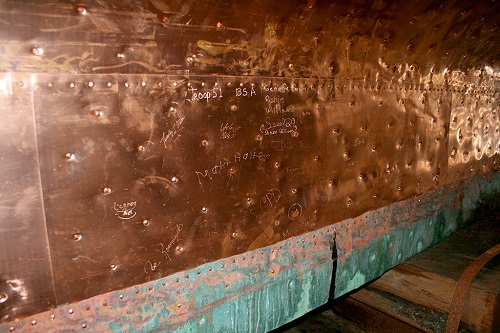Naval Engineering innovations
Nijisanji's empire is largely based on its fleet and takes pride in its shipbuilding. Defeats in the past have taught them hard lessons that won't be forgotten but in recent years, there has been some great innovations in shipbuilding that have allow them to be constructed stronger, larger and faster.
Copper bottoming of ships
A long problem of wooden ships was their bottoms being eaten by barnacles and other worms that cause ships to go into drydocks regularly to be fixed. Other solutions like a lead sheathing and using different chemicals were moderately successful at preventing this but coppering of the bottom of hulls was proposed by naval architect Yamashita Chuichi in 1096 as a better way of fixing this. It took a while to perfect this method, with gavalnic reactions between the iron rivets and the copper sheathing, the copper sheathing fall apart over time, and other issues being worked out. Finally, by 1115 VTE, it had been perfected by Ogami Mishita, who found out that using paper between the iron bolts and the copper would fix this issue. Coppering was a brilliant success but expensive, being limited to only newer ships. It took a lot of copper to properly make these plates that thankfully, Nijisanji had in ample amounts. It was planned that over time as ships were built and others phased out that it would be fully implemented on the fleet. It has started to spread to wealthy merchants as well, as the speed and maintenance advantages are so great thanks to coppering of the hulls.

Seven fours and capital ship classes
One of the great problems in design of large capital ships was lack of uniformity among the different ships. The Imperial navy realized that uniformity of classes was the future and that there was a need for a capital ship class that had a lot of firepower and good sailing qualities. Thus in 1088, naval designer Date Keisuke designed what became known as the "Seven Four". It was a perfect balance of sailing qualities and firepower that made it the standard capital ship design of the imperial navy for many years to come. Date also worked with Yamashita to standardize Frigate construction and larger ships than Seven Fours too. As of the current year, all Imperial Navy ships are built in classes and aside from certain ships are standardized. The "Classement" system of dividing all capital ships and frigates into their ranks as follows:
First Rank: 100+ cannons
Second Rank: 80+ cannons
Third Rank: 60+ Cannons
Fourth Rank: 40+ Cannons
Fifth Rank: 30+ Cannons
This system of classification was developed in 1102 by Grand Admiral Yokugawa for simplication of understanding in logistics. All of these reforms allowed the Imperial navy to become more organized and able to construct faster

Razée Frigates
One of the innovations allowed by the Seven Four was Razée Frigates. They were shaven down Third Ranks or large Four Rank ships of line that had a gun deck removed to convert them to large frigates. This was done because they were no longer suited to line combat and what it produced was frigates that were stronger than purpose-built frigates because they retain the hull construction of line ships while being as fast as frigates. Razées were are innovative design that allowed older ships to live a longer life after their conversion.

Rounding Aftcastle
A major disadvantage in battles was the weakness of the aftcastle of ships of line. If fired upon, it would chaos great destruction to the inside of the ship. Recently, there have been some experiments on frigates to fix this issue by rounding the aftcastle into a more study shape that has been implented already on the forecastles. The results of this concept are incomplete and still being tested, but the novelle idea will certainly help ships if it is successful.
